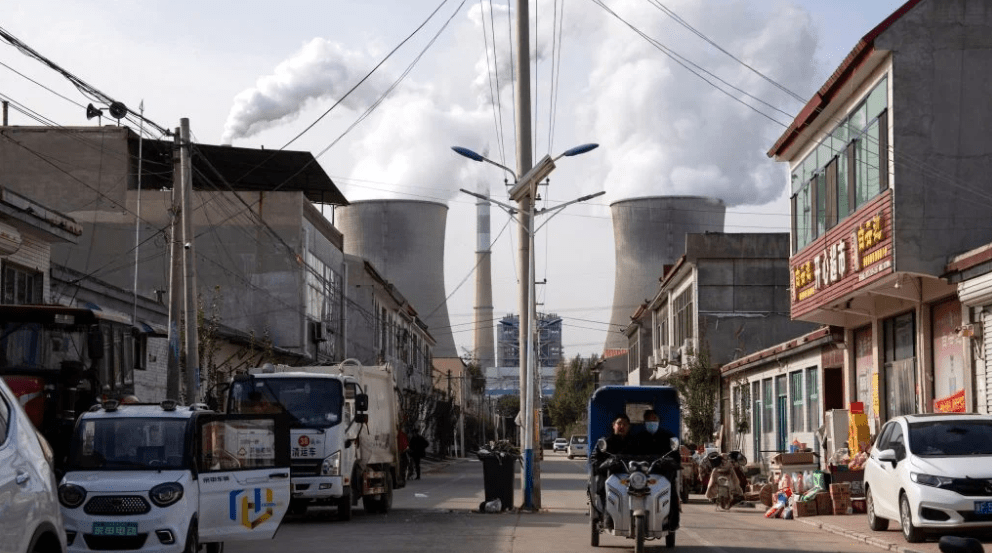
Following the emergence of Covid-19 and its impacts, China placed strong emphasis on coal power and energy-intensive heavy industry to ensure energy security and GDP growth. This has put it quite far from achieving its 2025 goals for energy and carbon intensity.
How can China ensure that these decisions do not make it even more difficult to achieve peak carbon emissions by 2030 and carbon neutrality by 2060? Speaking to Dialogue Earth, experts recommend stricter controls on coal, reforms in electricity markets and more rigorous management of energy supply and demand.
Almost impossible mission
China’s five-year economic plan for 2021-2025 set 20 binding targets, including a 13.5% drop in energy intensity and an 18% drop in carbon intensity (carbon emitted per unit of GDP). Meeting these requirements would have required annual falls of 2.8% and 3.9%, respectively.
In late 2023, National Development and Reform Commission Chairman Zheng Zhajie said the declines in both energy intensity and carbon intensity had been smaller than expected. According to a recent bulletin from the National Bureau of Statistics (NBS), energy intensity only fell by 2.5% in 2023, while carbon intensity remained stable.
Energy intensity fell by 2.7% in 2021 and carbon intensity by 3.8%, according to Dialogue Earth calculations. However, the declines in 2022 were only 0.1% and 0.8%.
Zheng Zhajie did not provide specific figures in his speech. However, Dialogue Earth calculations using the NBS bulletin show cumulative drops since 2020 of 3.3% in energy intensity and 4.6% in carbon intensity. Therefore, to meet its 2025 targets, China will now need to achieve two annual drops of 10.5% in energy intensity and 14% in carbon intensity, from 2023 levels.
“It is not possible for carbon intensity and energy intensity to drop that much in two years,” says Dr. Yang Fuqiang, a researcher at the Institute of Energy at Peking University. “There is no doubt that the objectives will not be achieved.”
The recently published “Government Work Report 2024” has set a goal of reducing energy intensity by 2.5% this year. “We are too far behind to get back on track overnight, so a target of 2.5% was set for the year,” Yang tells Dialogue Earth. “All we can do is try to get back on track in the time left.”
The problem: safety trumping efficiency
Professor Zhou Dadi, member of the National Expert Committee on Climate Change, said in an interview with Yicai.com that the disappointing progress is due to two reasons: Energy intensity has risen due to a combination of slowing economic growth and sustained in energy demand; while carbon intensity has been driven by growth in coal consumption, which accounts for around 60% of national carbon emissions.
Statistics for 2023 show a 5.7% increase in total energy consumption year-on-year, while GDP grew by only 5.2%. This goes against a years-long trend in China where GDP growth was higher than energy consumption.
“Although the Covid-19 pandemic had a significant impact on the services sector, slowing GDP growth, energy demand, especially related to life activities, has continued to grow more rapidly, meaning reductions less ideal in both energy and carbon intensity,” Zhou told Yicai.com.
Meanwhile, coal consumption grew faster than GDP for the second year in a row. According to our investigation, this had not happened since 2005.
In that year, China had recently joined the World Trade Organization and every sector of its rapidly growing economy was demanding more energy. Coal prices skyrocketed, giving rise to the “coal king” phenomenon: super-rich coal mine owners.
But in 2024, the Chinese economy faces several downward pressures. So why is demand for coal on the rise?
“We are in a transition period, so GDP growth is slow,” Yang says. «International experience shows that when GDP growth slows, energy consumption should follow the same path. However, we are seeing energy consumption growing faster than GDP. “There are many problems behind this, but a very important one is the lack of sufficient attention to energy efficiency.”
The electricity sector was responsible for more than 80% of the growth in coal consumption in 2023 (equivalent to about 100 million tons of coal), according to an analysis by the Climate Change and Energy Transition Program of the Energy Institute of the University from Beijing.
Yang thinks the “anomalies” in coal consumption over the past two years are due to the government prioritizing supply demands over improvements in energy efficiency:
“Over the past three years, electricity shortages in northeast China, drought in Sichuan and energy market instabilities caused by the war in Ukraine have led the government to prioritize security of supply. Additionally, it was necessary to ensure that supply could keep pace with returning demand during the pandemic recovery. So, with coal being cheap and pricing mechanisms still preventing electricity prices from rising, China burned a lot of coal to generate the necessary power.
When electricity is cheap, businesses and individuals see no need to limit its use. “Energy prices remain very low and supply is guaranteed,” adds Yang. “The financial benefits of saving energy are limited and there is little incentive for any person, company or individual, to make an effort.”
Yang emphasizes that these energy and carbon intensity targets are binding. This means that failure to comply with them will be taken seriously by the central government and relevant ministries, with investigations and corrective measures sure to follow.
Therefore, the 2024 Government Work Report has introduced a resource consumption strategy. It will drive faster implementation of energy and water saving measures in key sectors, and the development and use of advanced energy saving and carbon reduction technologies to create green and low carbon supply chains.
Peak early?
An important qualification was added to the energy intensity figure reported in the recent Office for National Statistics bulletin: it now excludes energy from non-fossil sources and the petrochemical sector. This is significant for two reasons.
First, reduce the energy intensity figure, as Dialogue Earth has explored. This explains the apparent contradiction in the 2023 figures: that energy consumption is growing faster than GDP, but energy intensity is falling.
Second, the exclusion is an adaptation to China’s shift in focus from controlling energy consumption to controlling carbon emissions. It is intended to provide more freedom for the growth of renewable energy, as it represents a growing proportion of China’s energy consumption.
In 2023, coal accounted for 55.3% of all energy consumed in China. However, that figure is declining annually, because the proliferation of clean generation is expanding the country’s energy total. Wind and solar energy have seen huge growth over the past five years, with their share of the energy mix increasing from 23.3% in 2019 to 26.4% last year, a trend that is expected to continue.
Yang believes that the “unusually rapid” growth in coal production and use over the past two years could actually lead to an earlier carbon peak. Although it is not the central government’s policy to ban coal, the government has imposed a “strict and reasonable” limit on coal consumption. The coal boom over the past two years may have been an excessive exercise in ensuring “reasonable” supply, but the central government will now be “strict” about any further expansion.
“There will be significant drops in additional coal-fired power capacity from now on and there is a high probability that China will reach its 2030 carbon peak target early, in the next two to three years. The energy consumption plan that China is developing ensures economic growth, and although specific energy-intensive industries such as coal chemicals and petrochemicals are still growing, the output of most other energy-intensive industries has already reached its peak. beak.”
But Yang also points out that, without a concrete number for “peak carbon,” there is a risk that this peak will be higher and last longer. This will make it difficult to achieve the goal of carbon neutrality by 2060. To avoid this, he adds, China needs stricter measures to control coal, as well as reforms and better management of supply and demand in its energy markets.
Note: this is an article republished from “The Dialogue Earth” through a cooperation agreement between both parties for the dissemination of journalistic content. Original link.
Source: https://reporteasia.com/opinion/2024/04/24/crecimiento-emisiones-china-no-desacelerando-igual-que-pib/

